#chinese salt and pepper seasoning mix
Text
SAUC'D LOWNSLOW

Website: https://www.saucdlownslow.com
SAUC'D LOWNSLOW is a family-owned business specializing in all-natural, freshly ground spice blends, seasonings, salts, and Mayonnaise. Founded in 2020, they focus on providing high-quality, local, and affordable products. Their range includes unique blends like The Smoked Fennel Salt, The Not Chicken, Chicken Salt, and various spice rubs. They also offer private label blending services, catering to both businesses and individuals seeking customized products. Passionate about food education, SAUC'D LOWNSLOW aims to help customers create delicious food and find value in their culinary creations.
Facebook: https://www.facebook.com/saucdlownslow
Instagram: https://www.instagram.com/saucdlownslow
Tiktok: https://www.tiktok.com/@saucdlownslow
Youtube: https://www.youtube.com/channel/UCrf6SfleJ3s9uCx9tju6LFQ/about
Keywords:
bbq accessories
meat temperature guide
meat spice rub
chicken spice rub
paprika powder
chicken seasoning blend
bbq spice rub
bbq clothing
cooking spices
cooking apparel
paprika seasoning
bbq flavors
bbq spices and rubs
grill seasonings
meat rub with coffee
gourmet food products
culinary spices
culinary apparel
gourmet bbq rubs
barbecue apparel
bbq merchandise
cooking temperature guide
fish temperature guide
gourmet paprika
sweet spice blend
baking spice mix
sweet spice rub
unique spice blends
coffee rub for beef
coffee rub for pork
high quality seasonings
premium spice blends
food and spice accessories
spice rub kits
unique culinary blends
barbecue blends
grill masters spices
smokehouse seasonings
grill seasoning blends
barbecue spice kit
saucd lownslow short sleeve unisex t shirt
saucd lownslow ribbed knit beanie
saucd lownslow snapback hat
saucd lownslow youth jersey t shirt
grill masters apparel
magnetic temperature guide for meat and fish
magnetic cooking guide
kitchen temperature guide
sweet paprika grade 100 asta
naturally smoked paprika
high grade paprika
smoked paprika for cooking
paprika for meats
paprika for grilling
the sugar & spice blend dessert mix
dessert spice blend
gourmet dessert seasoning
sugar and spice mix
the one eighty blend spice rub
the spilt gin blend spice blend
the hot chicken blend spice rub
gourmet spice rub
spice rub for grilling
gin infused spice blend
gentlemens blend coffee spice rub
coffee spice rub seasoning
coffee rub for meats
gourmet coffee rub
coffee rub for grilling
coffee rub for smoking
coffee spice blend
coffee flavored seasoning
cajun seasoning
black salt
mexican spice blend
chipotle mayonnaise
vegan mayonnaise
celery salt
truffle mayonnaise
fleur de sel
all purpose seasoning
jamaican jerk seasoning
pink himalayan salt
lemon pepper seasoning
steak seasoning
garlic mayonnaise
spicy mayonnaise
truffle salt
garlic salt
smoked salt
maldon sea salt
olive oil mayonnaise
lemon salt
rosemary salt
fish seasoning
poultry seasoning
low fat mayonnaise
flavored mayonnaise
egg free mayonnaise
pesto mayonnaise
indian spice blend
onion salt
citrus salt
mediterranean spice blend
flavored salt
caribbean spice blend
spicy salt
italian herb seasoning
asian spice blend
chipotle salt
lavender salt
gourmet mayonnaise
lemon mayonnaise
basil mayonnaise
saffron mayonnaise
mustard mayonnaise
sun dried tomato mayonnaise
roasted red pepper mayonnaise
herb infused salt
bacon flavored salt
gourmet spice blends
herb seasoning blend
greek seasoning blend
southwest seasoning blend
bbq seasoning
marinade seasoning
herb infused mayonnaise
seasoned salt blends
citrus spice blend
#spice blends#fajita seasoning mix#ranch mix seasoning#mexican seasoning mix#chicken seasoning mix#greek seasoning mix#bbq spice blends#best spice blends#common spice blends#every plate spice blends#organic spice blends#spicy spice blends#salt and pepper seasoning mix#best online spice store#herbs and spices online store#online spice store#online spice store australia#cooking with spices#cooking with sumac spice#all natural spices#bulk spice blends#buy spice blends#buy spice blends online#no salt spice blends#spice blends for sale#spice blends online#unique spice blends#spice blend gift set#chinese salt and pepper seasoning mix#salt free seasoning mix
1 note
·
View note
Text
The Mid-Autumn Festival (中秋节), a Chinese celebratory season observed by many East and Southeast Asians, has begun. Held on the 15th day of the eighth lunar month, which is in the middle of autumn, the festival marks the end of the season’s harvest and is a time to appreciate the moon at its fullest and brightest. Besides feasting eyes on the moon and lanterns of different shapes and sizes, Mooncakes (月饼), a rich pastry with all sorts of fillings, are undoubtedly the main highlight of the festival and are traditionally shared among family and friends.
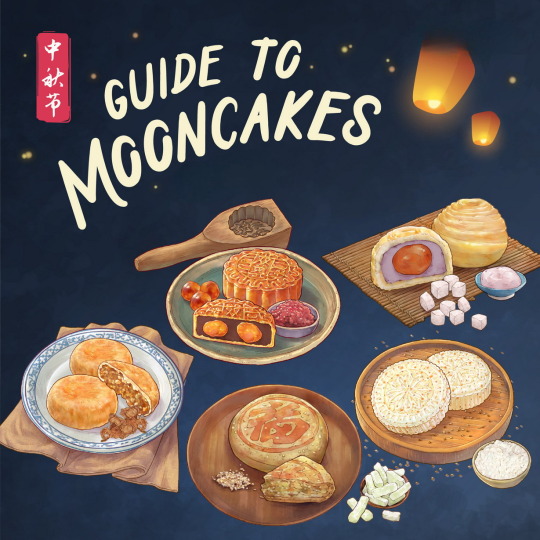
The Cantonese Mooncake (广式月饼) is the most commonly found traditional mooncake in Singapore. Its fillings consist of lotus seed or red bean paste and usually include one, two or four salted duck egg yolks. Many would also be familiar with the snow skin variant that was created in Hong Kong in the 1960s as a healthier alternative to traditional baked mooncakes. The fillings and a ball of dough are traditionally pressed into a wooden mould, which embosses intricate wordings of the pastry shop’s name or stuffing on top of the pastry.
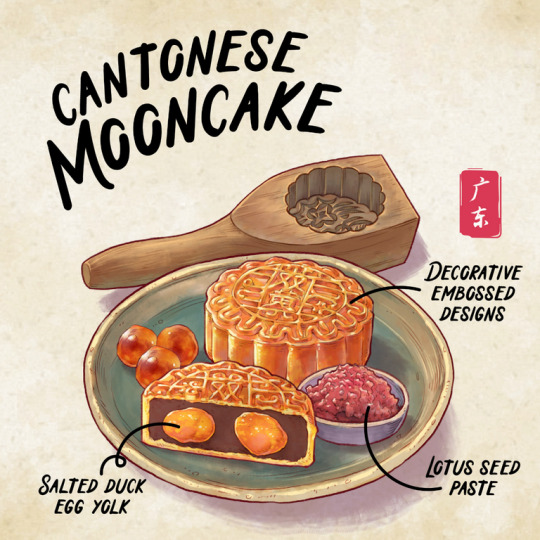
A mooncake with various flavours such as rich, savoury-sweet and peppery, the Hainanese Mooncake (海南月饼), also known as Su Yan Bing (酥盐饼) is traditionally filled with ingredients such as fried shallots, lard, salt, white pepper, rose-flavoured white sugar, sesame seeds, melon seeds and dried wild tangerine skin peel. The filling is encased in a thin crust made with flour, salt and lard.
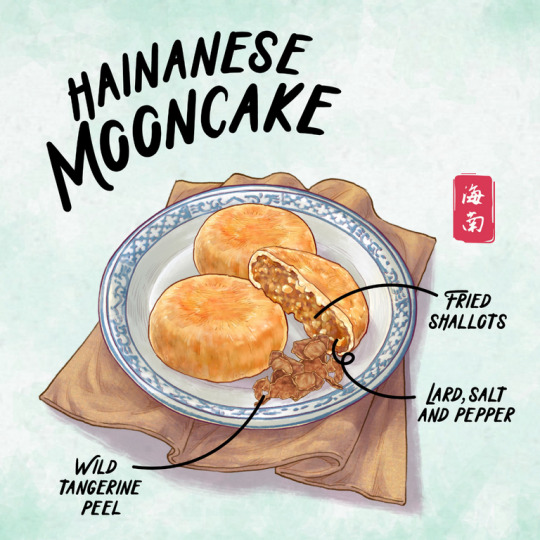
The Hakka Mooncake (客家月饼) is also called Yu Gao (月糕) and is a flat, snow-white disc that is typically made with cooked glutinous rice flour and sugar, giving it a crumbly and powdery texture. It is usually embellished with more intricate designs, often with animals and flowers. Although it doesn’t usually contain any fillings, some come with candied winter melon, desiccated coconut and sesame seeds mixed with glutinous rice flour, sugar, margarine and water.

Easily distinguishable by the red stamp of Chinese characters on the top of the crust and its white disc-shaped pastry which resembles a bright moon, the Hokkien Mooncake (福建月饼) consists of a dry and sweet filling that is made of candied winter melon, tangerine peel, melon seeds, sugar, and cooked with lard or peanut oil. A less common type is a savoury version with minced meat filling. Once known as Scholar Cakes (状元糕), they were given to those who took part in the Imperial examinations. Today, it is given as a symbol of good luck to those who are about to sit for their exams.
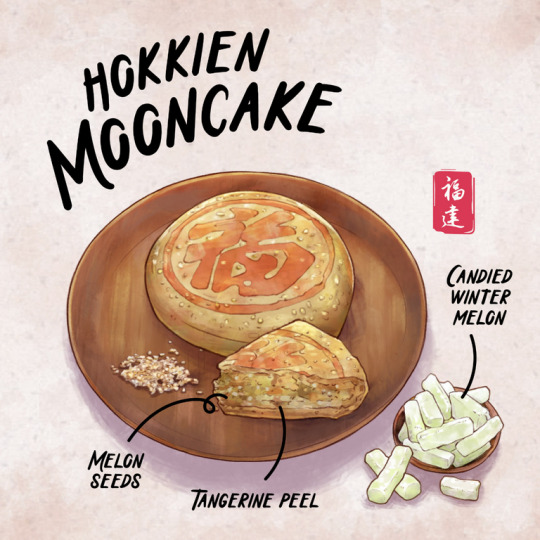
Many would be familiar with the Teochew Mooncakes (潮州月饼). It has a crispy, spiral-layered crust that crumbles easily. It originated from the Chaoshan (潮汕) area in Guangdong Province and typically consists of yam paste and a salted duck egg yolk. Other traditional versions of the Teochew mooncake are still made by old school bakeries in Singapore. For example, La Bia (朥饼 or lard biscuit), where ‘La’ refers to pork oil, has a thinner, flaky crust with a thick mung bean or red bean filling. There are also alternative fillings including red bean, mung bean or lotus seed paste. There is also a steamed version of the typically baked Teochew mooncake, called La Gao (朥糕). It can either be served plain or with a mung bean filling.
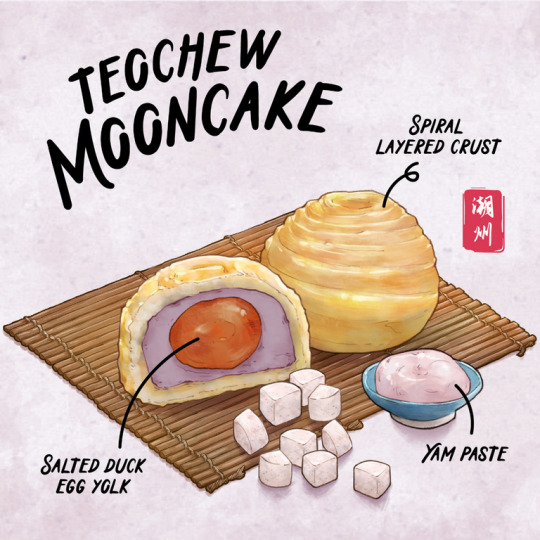
A Snow Skin Mooncake (冰皮月饼) variant was created in Hong Kong in the 1960s as a healthier alternative to traditional baked mooncakes. Similar to mochi, its crust is made of glutinous rice flour and varies in colour, based on the flavours used. And unlike traditional mooncakes, these are best served cold!
youtube
Mooncake information and drawings courtesy of Ministry of Culture, Community and Youth.
#Mid-Autumn Festival#中秋节#Mooncake Festival#农历八月十五#Chinese Culture#Chinese Tradition#Celebration#Mooncake#月饼#Cantonese Mooncake#广式月饼#Hainanese Mooncake#海南月饼#Hakka Mooncake#客家月饼#Hokkien Mooncake#福建月饼#Teochew Mooncake#潮州月饼#Snow Skin Mooncake#冰皮月饼#Recipe#Video#Youtube#Snack#Dessert#Asian Food#Food#Buffetlicious
115 notes
·
View notes
Text
Apr 6-8, restaurant and fast food:
Started to go around visiting other relatives, went to a restaurant that had more local specialty dishes.
Another cold dish appetizer. This one is a mix of peanuts, spicy vegetables, century eggs, Chinese vinegar, and cooked clam meat. I'm not a big fan of century eggs, but I like the clams:

Deep fried river shrimp with dry seasoning of salt, pepper, cumin, and roasted sesame:

Dry-braised turbot fish (dry-braise/干烧 is a method of cooking that originated from Sichuan):

Sugar and vinegar small yellow croaker (sugar and vinegar/糖醋 is another general type of dish, and the flavor profile is sweet and sour, but it's very much not the same as "sweet and sour" in Americanized Chinese food, so I opted for the literal translation here):

Stir fried snow peas, shrimp, cashews, and Chinese sausages:

Soup with eggs, tofu, shrimp, and Chinese ham:

Also, Chinese KFC breakfast is very very different from American KFC. They have Guangdong-style congees and xiaolongbao buns:



But I went for a xianbing/馅饼 instead, which is a stuffed and baked flatbread. In this case it was stuffed with grilled tenderloins and onions, and favored with cumin (my favorite):

72 notes
·
View notes
Note
forrest!! SOS!! i have no good food to eat!! ik u can cook so can u tell us some yummy recipes?
oh god i feel like senshi because im so so very late to this ask because ive been in a slump with cooking myself and youve definitely eaten by now. BUT i have a few that i make either when i want comfort food that still checks some boxes of being kind of nutritious or that are just fast
i. spam musubi but its not actually
spam musubi are these awesome hand held things. sometimes they have egg sometimes they dont but i will eat a whole can worth in one go. so i do it as a bowl instead

i start jasmine rice in our rice cooker and chop the spam into cubes vs slices like it would be for musubi. fry them on medium high until theyre crispy. then ill julienne an onion and add it to the spam. once the onion is starting to soften ill add the sauce. the recipe i saw was 2tbsp soy sauce, 1 tbsp mirin with like a spoon full of sugar (honestly it was probably just under a tbsp) but ive been cheating recently and using a japanese bbq sauce i found at our local asian grocery store. once everything is coated i cook it a few mins so the sauce thickens up. by then the rice should be done and then you just take a scoop of each and i add seaweed on top
i know its not proper but since will doesnt like the sweet savory combo and im the only one eating it this way is easier for me to handle. i can store the rice and spam separately so nothing gets mushy and even refry the spam when i want to heat it back up
ii. black bean, pepper and cheese quesadilla
this is actually how i got will to try beans. i just take a can of black beans and dump the whole thing into a pot and cook on medium until i can smash them. ill also fry peppers and onions on medium until they have a little char. spices are honestly up to you and how spicy you want it. i usually put salt, pepper, cumin, paprika, chili powder and garlic in with the beans. once the beans are mostly smashed and the peppers cooked ill throw them together and smash them more just so everything is easier to spread onto a tortilla. that plus you can add your cheese. ive shredded my own and used grocery store mixes so its up to you!
iii. spicy garlic tofu
almost no notes on this. i use less maple syrup than the recipe calls for so 1tbsp of everything in the sauce. and instead of gochujang i use a chinese chili paste, imo it ends up less ketchup flavored but if you like ketchup then just use gochujang
iv. https://thecookiewriter.com/roasted-mushroom-pot-pie/
i dont make this as often but this is a recipe i use as a base and then cheat. i swap in frozen veggies and it speeds everything up
v. hotpot
i love making hotpot at home. its super easy skill wise it just takes some time. you can buy premixed hot pot bases from the grocery store if you have an asian grocery store near you and you just dunk stuff in the soup until its cooked. you just need to watch out for the spice level of the broth
will and i will usually get thinly sliced beef, rice cakes, udon noodles, fish cakes, bok choy and mushrooms. all you do is bring the broth to a boil and cook your ingredients. sometimes i dunk with chopsticks other times i cook with a small strainer lol
38 notes
·
View notes
Text
nostalgic food
i’ll want to reference this in the future

gỏi cuốn (spring roll with chicken, egg, rice noodle, carrot, lettuce, avocado)
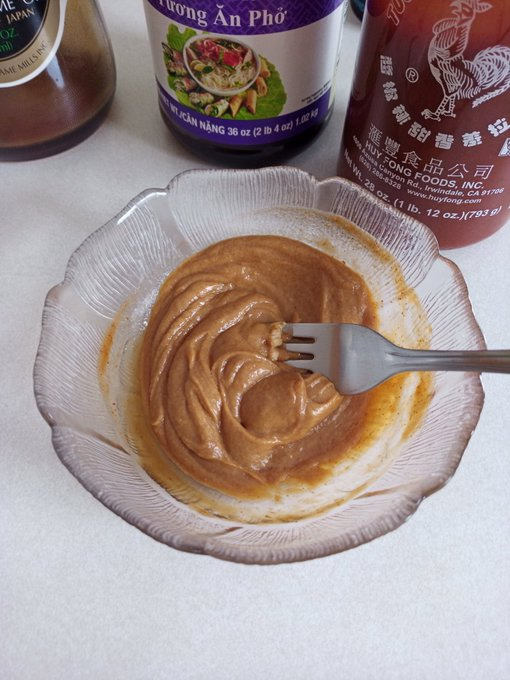
peanut sauce is just peanut butter+water, hoisin+sriracha sauce, and a tiny bit of sesame oil (tastes good with almost anything imo)

yellow curry
rice noodle with chicken, potatoes, yams, onions, carrots in a creamy coconut milk and yellow curry paste broth
lemon juice and salt mix with garlic chili for dipping

bò kho (vietnamese beef stew)
kho is a cooking technique where a protein is braised in a mixture of fish sauce, sugar, and water or coconut juice to make a salty/savory result
bread dips in stew beef/potatoes dip in lime juice/salt/pepper mix
cucumber slices to offset the salty

xá xíu (cantonese style bbq pork)
the seasoning mix is made of sugar, powdered soy sauce, onion and garlic powder, and spices
the pink color very much freaked out middle schoolers at lunch

cơm tấm (broken rice, grilled pork, egg, pickled carrots/daikon with scallions/oil garnish and fish sauce)
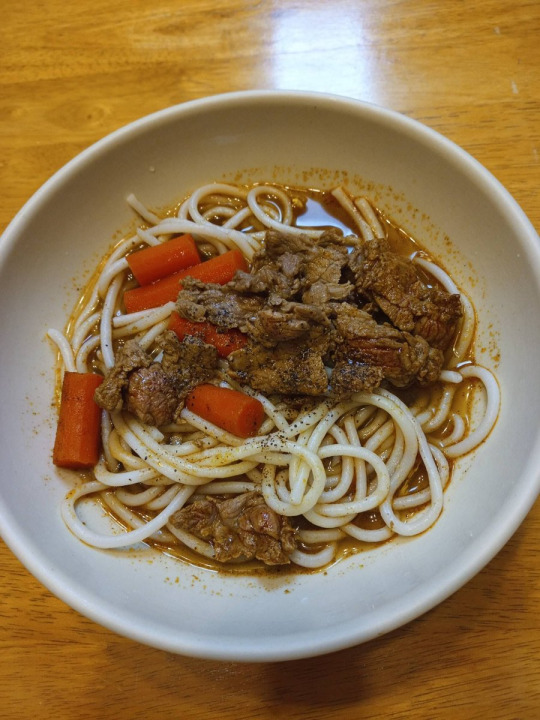
bún bò huế (thick round rice noodle with beef soup)
more "fun" than phở imo
bún bò broth: spicy salty flavor (lemongrass, spicy chili, fermented shrimp paste, fish sauce)
phở broth: earthy sweet flavor (cinnamon, star anise, onion, ginger, garlic, herbs)
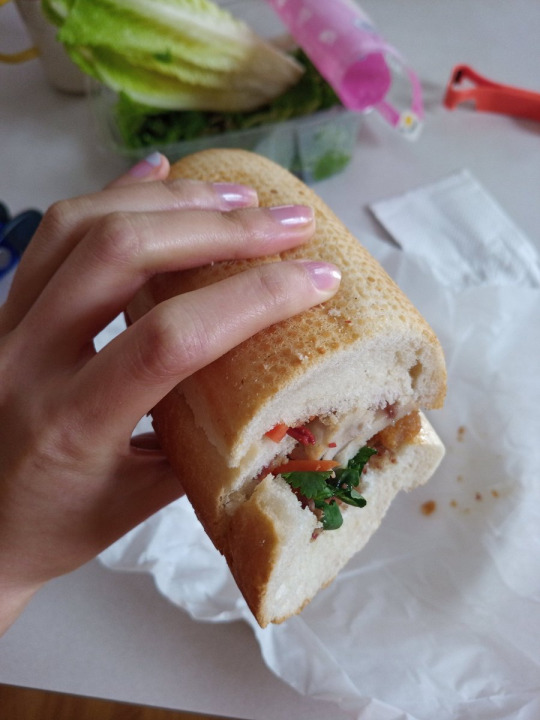
bánh mì (baguette sandwich with chả lụa (pork sausage), xá xíu (cantonese style bbq pork) coriander leaf (cilantro), cucumber, pickled carrots, and pickled daikon combined with pâté and buttery mayonnaise)

salmon instead of nem nướng̣ (viet grilled pork) with bánh hỏi (rice vermicelli)
feat nori (dried edible seaweed)
wrapped with lettuce and dipped in nước mắm (fish sauce)
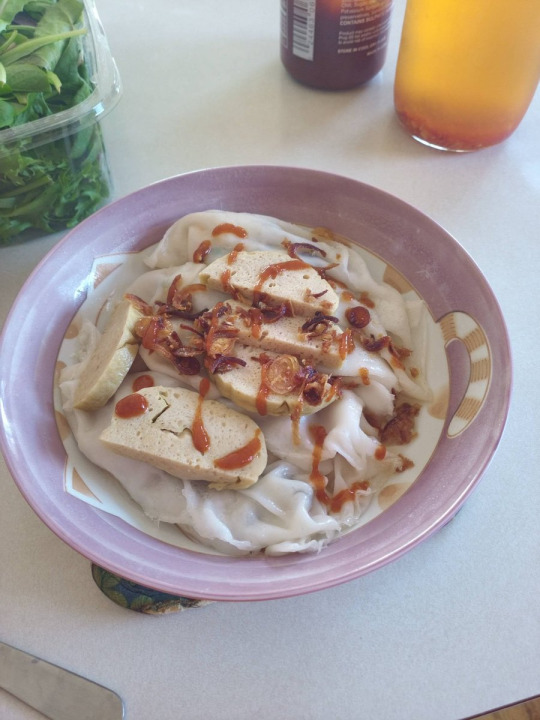
bánh cuốn (rice noodle rolls filled with ground meat, wood ear mushrooms, onions)
topped with chả lụa (pork sausage) and fried red onions and nước mắm (fermented salted fish sauce)
a fav of grandpa's
pizza man mispronounces it as "bun goo" which makes my mom giggle cause the way he says goo sounds like penis

bánh tét (glutinous rice rolled in a banana leaf into a thick, log-like cylindrical shape, with a mung bean and pork filling)

bánh rán (deep fried sesame ball filled with mung bean)
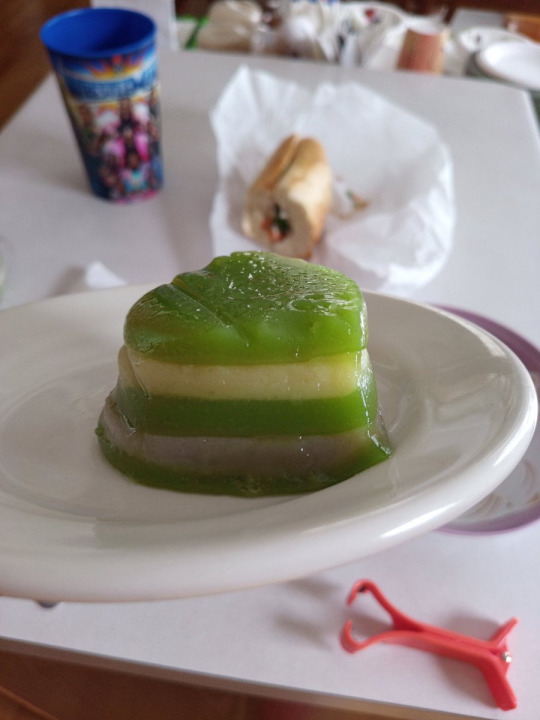
bánh da lợn "pig skin cake" (tapioca starch, rice flour, mung bean, taro, coconut milk)
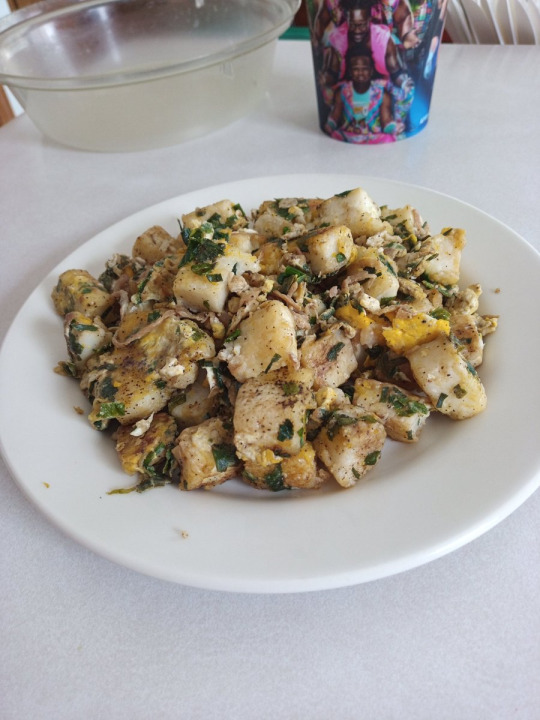
bánh bột chiên (fried taro rice cake, a fav of pizza man)
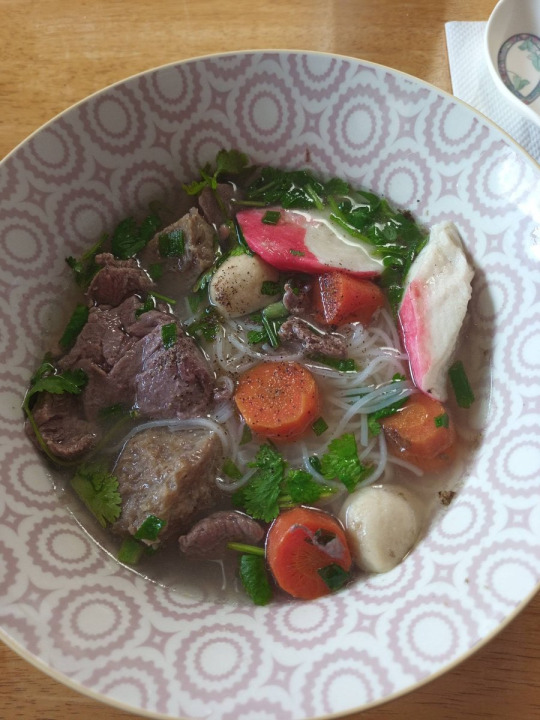
phở (broth: earthy sweet flavor- cinnamon, star anise, onion, ginger, garlic, herbs)
ive called phở mid but while eating this i was like huh this is good actually then my dad says this time he simmered chicken bones for hours like he's supposed to instead of using canned broth

improvised bún thịt nướng (rice noodle bowl with chopped grilled pork, egg roll, veggies, crushed peanuts, fish sauce)
a way to deal with leftover noodles from gỏi cuốn
every time i eat this i think of the time me and pizza man were in new orleans and he asked if i wanted to eat at a viet place and i was surprised cause he's not really into a lot of viet food but anyway i got bún thịt nướng
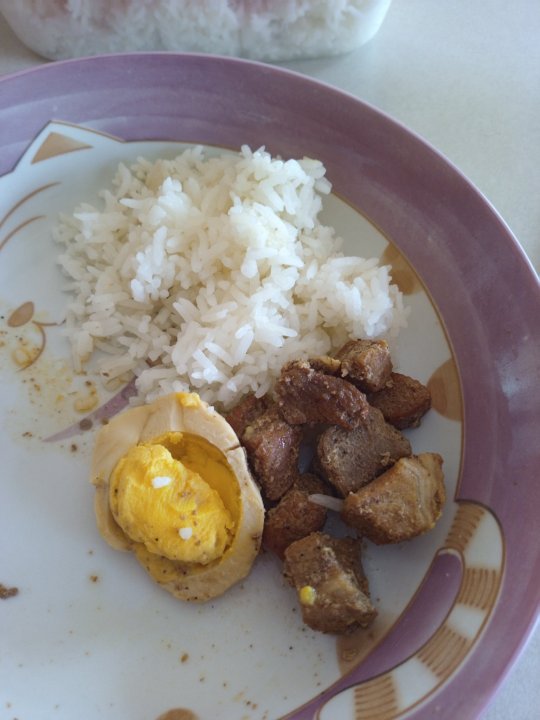
thịt kho (pork with eggs braised in sticky savory caramel of sugar, fish sauce, coconut water)
i have distinct flashbacks of being in the middle school cafeteria with my thịt kho and kids around me going "what is that??", "ewwww" lol
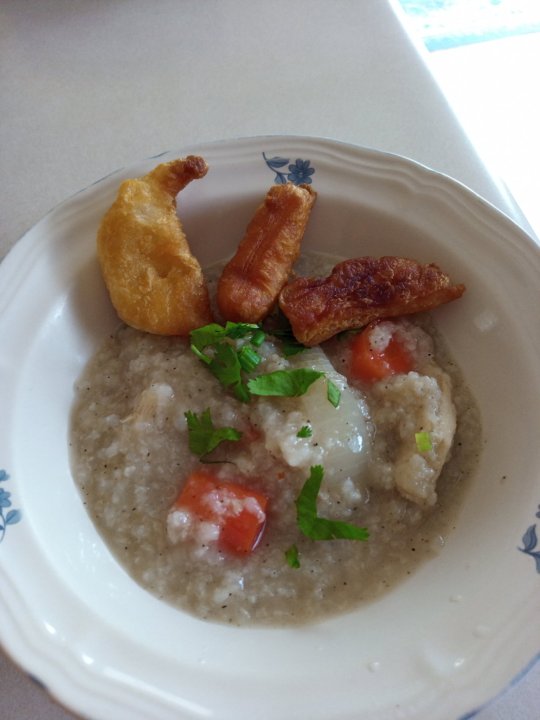
cháo (rice porridge with chicken or a white meat fish- often served with crunchy cabbage salad)
my dad likes it with youtiao (chinese donuts)
being sick means eating this! but we also eat it a lot when we’re not sick!
when my mom was young she would say yes to any dude that asked her out and order an obscene amount of food/the most expensive things on the menu and never hear from them again but my dad took her to a cháo place cause that was his favorite but apparently for cheapskates
he proposed two weeks later and she said yes
my mom is such a menace i wanna be just like her
70 notes
·
View notes
Text
Crab imperial is one of my favorite dishes from the Chinese buffet. Here’s my recreation on it. I use salt, pepper, garlic salt, garlic powder, old bay seasoning , celery, onions, green onion, cream, cheese, mayo, Worcestershire sauce, sour cream, imitation crab meat, mozzarella cheese, and sharp cheddar cheese. Mix all your ingredients together until incorporated and save some cheese to put on the top before baking at 400 Fahrenheit for 18-20 minutes .
3 notes
·
View notes
Text

🌟 4 Spotlight Menus of Thai Cuisine in the World’s Best List 🇹🇭🥘
🇹🇭 Thai cuisine, known for its vibrant flavors and aromatic fresh herbs and spices, has captivated both local enthusiasts and global food lovers, earning a prominent place on the international culinary stage. This article explores four spotlight menus that have distinguished themselves on the world’s best list of Thai dishes by TasteAtlas.
1. Pad Kaprao
Pad Kaprao is one of the most known Thai stir-fry dishes, and became famous for its appetizing appearance and flavor. This dish is flavored with soy sauce/oyster sauce, sugar, and fish sauce.
The origins of this iconic Thai dish are believed to date back 334 years ago, based on references from the La Loubère archives (in the year 2230 B.E.), which mentioned that Thai people adopted holy basil from Brahmanism, where it was used in worship rituals.
The version of Pad Kaprao that we are familiar with nowadays is speculated to have emerged during the reign of King Rama VII, adapted from Chinese cuisine brought by Chinese immigrants who sold it in local diners. Others claim that the Chinese cooks modified the Thai dish "beef stir-fried with tree basil," reducing its spiciness to create what is now known as Pad Kaprao.
🍴 How to enjoy - Serve with Jasmine rice, topped with a fried egg. Firstly, add a few drops of fish sauce with chili. Then, let's mix the yolk with the rice.
2. Khao Soi (Thai Curry Noodles)
Khao soi, a signature dish of Northern Thailand, features flat egg noodles in a creamy coconut curry broth. Typically, crispy fried egg noodles are added on top for a crunchy texture, while the dish is served with condiments such as shallots, chilies, pickled mustard greens and lime.
"Khao Soi" derives its name from the ancient method of making noodles by hand, before the advent of machinery for noodle production. To make the noodles used in Khao Soi, wheat flour, eggs, salt, and water are mixed together and kneaded until well combined. The dough is then pressed and rolled out into sheets, which are subsequently sliced with a knife into noodles. This manual slicing of the dough sheets is why the dish is called "Khao Soi," which translates to "sliced rice" in English.
🍴 How to enjoy - Before eating, add lime juice and chili paste to adjust the sourness or spiciness of the broth. Then, mix the condiments well with the curry and enjoy the Noodles.
3. Panaeng Curry
Panaeng curry is a rich and mildly spicy broth with a harmonious blend of coconut milk and panaeng curry paste. This curry is typically enjoyed with various types of meat such as pork, chicken, beef and duck, and is garnished with shredded kaffir lime leaves and red chili peppers.
The original recipe for Panaeng curry was made using a whole chicken, prepared by rubbing the legs together before placing it in the curry pot, mentioned in Siam Rat Newspaper (2515 B.E.) written by M.R. Kukrit Pramoj. This method of preparing the chicken, referred to as "legs rubbing," is believed to be the origin of the name "Panaeng," which means 'cross-legged sitting' in meditation.
The traditional Thai recipe for Panaeng curry is believed to have started during the reign of King Rama V, considered a royal court dish, and has been documented by M.L. Nueang Nilrat.
🍴 How to enjoy - Serve with jasmine rice on a separate plate, add the curry to the rice and scoop it up!
4. Tom Kha Gai
Tom Kha Gai is full of savory and satisfying taste from Central Thailand. Galangal's pungent flavor adds an intriguing counterpoint to the creaminess of coconut milk, bursting in a delightful aromatic dish. The broth is typically cloudy white in color and is seasoned with various herbs, similar to those used in Tom Yum soup.
‘Tom’ means to boil, ‘Kha’ means galangal, and ‘Gai’ means chicken. So, chicken is the original protein used in Tom Kha Gai, but you can replace it with other options such as meat or white fish. Alternatively, you can make it vegan by using only mushrooms.
🍴 How to enjoy - Serve with Jasmine Rice; paired with other Thai dishes (e.g. Thai omelet)
.
⭐ ชวนรู้จัก 4 เมนูอาหารไทยที่ติดอันดับอาหารที่ดีที่สุดในโลก 🇹🇭🥘
อาหารไทย เป็นที่รู้จักกันดีในเรื่องของรสชาติที่จัดจ้านครบรส ผสานด้วยความหอมของสมุนไพรและเครื่องเทศ จนได้รับการยอมรับในเวทีอาหารระดับนานาชาติ ในบทความนี้ เพจ Thai SELECT ขอพาทุกท่านไปสำรวจ 4 เมนูอาหารไทยที่โดดเด่น ติดอันดับเมนูที่ดีที่สุดในโลก จัดอันดับโดยเว็บไซต์ด้านอาหารชื่อดัง “TasteAtlas”
1. ผัดกะเพรา
ผัดกะเพรา เป็นเมนูอาหารไทยประเภทผัดยอดนิยม โดดเด่นด้วยรสชาติที่อร่อยจัดจ้าน รับประทานง่าย เป็นเมนูที่พบได้ในทุกร้านที่มีอาหารไทย ส่วนมากนิยมปรุงรสด้วยซีอิ๊วขาวหรือซอสหอยนางรม น้ำตาล และน้ำปลา
จุดเริ่มต้นของเมนูที่มีชื่อเสียงโด่งดังที่สุดของอาหารไทยนี้ สันนิษฐานว่า มีที่มาตั้งแต่เมื่อ 334 ปีที่แล้ว อ้างอิงจากหลักฐานจดหมายเหตุลาลูแบร์ (พ.ศ. 2230) ซึ่งได้มีการระบุถึงใบกะเพราไว้ว่า “ผักลางชนิดที่มีกลิ่นดี เช่น กะเพรา” โดยชาวไทยในสมัยนั้นน่าจะรับเอาต้นกะเพรามาจากศาสนาพราหมณ์ที่มักจะใช้ใบกะเพราในการบูชาเทพเจ้า
สำหรับเมนูผัดกะเพราในแบบที่เ���าคุ้นเคยกันนั้น สันนิษฐานว่าน่าจะเกิดขึ้นราวสมัยรัชกาลที่ 7 โดยดัดแปลงจากอาหารจีนที่คนจีนนำเอามาขายในร้านอาหารตามสั่ง บ้างก็ว่าชาวจีนได้ทำการดัดแปลงเมนูกะเพรามาจากเมนู “เนื้อผัดใบยี่หร่า” ของชาวไทย แต่ลดความเผ็ดร้อนลง เท่านั้นเอง
🍴 วิธีการรับประทาน - นิยมทานคู่กับข้าวหอมมะลิร้อน ๆ เสิร์ฟร่วมกับไข่ดาว มีน้ำปลาพริกเป็นเครื่องปรุงเพื่อเพิ่มรสชาติความหอมและเผ็ด
2. ข้าวซอย
ข้าวซอยเป็นหนึ่งในเมนูอาหารพื้นเมืองทางภาคเหนือของประเทศไทย เส้นมีลักษณะคล้ายเส้นบะหมี่ แต่มีลักษณะแบน ใส่ในน้ำซุปที่มีความเข้มข้นนุ่มนวลจากเครื่องแกงและน้ำกะทิ โรยปิดท้ายด้วยเส้นที่ถูกนำไปทอดจนกรอบ นิยมเสิร์ฟคู่กับเครื่องเคียงต่าง ๆ อาทิ หอมแดง พริกคั่วน้ำมัน ผักกาดดอง และมะนาว
โดยชื่อเรียกของเมนู “ข้าวซอย” นั้น เริ่มมาจากกรรมวิธีในการทำเส้นในสมัยโบราณ ที่ยังไม่มีเครื่องจักรในการผลิตเส้นบะหมี่ที่ใช้ทำข้าวซอย ดังนั้นคนสมัยก่อนจึงใช้วิธีการทำเส้นสด ด้วยการนำแป้งข้าวสาลี ไข่ เกลือและน้ำ มาผสมกันแล้วนวดคลึงจนเข้ากันดี จากนั้นกดรีดให้แป้งเป็นแผ่นใหญ่ แล้วเอามีดมาซอยแผ่นแป้งให้เป็นเส้น จึงเรียกว่า “ข้าวซอย” นั่นเอง
🍴 วิธีการรับประทาน - ก่อนรับประทาน ให้บีบมะนาวสักเล็กน้อย และใส่พริกคั่วน้ำมันเพื่อเพิ่มรสชาติ จากนั้นคลุกเคล้ากับเครื่องเคียงให้เข้ากัน
3. แกงพะแนง
พะแนงเป็นแกงที่มีรสชาติเค็มหวานมันและเผ็ดเล็กน้อย เนื้อสัมผัสมีความข้น สามารถใส่เนื้อสัตว์ได้หลากหลาย ทั้งเนื้อหมู เนื้อวัว ไก่ และเป็ด เวลาเสิร์ฟโรยหน้าด้วยใบมะกรูดฝอยและพริกชี้ฟ้าซอยเพื่อเพิ่มสีสัน
สำหรับต้นกำเนิดของแกงพะแนงนั้น มีกล่าวถึงโดย ม.ร.ว คึกฤทธิ์ ปราโมช เขียนไว้ในหนังสือพิมพ์สยามรัฐ ตีพิมพ์ในปี พ.ศ. 2515 ว่า แต่เดิมนั้นแกงพะแนงปรุงโดยใช้ไก่ทั้งตัว โดยจับขามาขัดกันก่อนที่จะเอาลงหม้อแกง ซึ่งการขาขัดไก่นี่เอง จึงเป็นที่มาของชื่อเรียกว่า “พะแนง” ในความหมาย ‘ท่านั่งขัดสมาธิ’ นั่นเอง
สำหรับสูตรแกงพะแนงต้นตำรับของไทย เชื่อกันว่าเริ่มต้นในสมัยรัชกาลที่ 5 ซึ่งถืออาหารตำรับชาววัง ที่มีการบันทึกไว้โดย ม.ล.เนื่อง นิลรัตน์
🍴 วิธีการรับประทาน - นิยมรับประทานคู่กับข้าวหอมมะลิ
4. ต้มข่าไก่
ต้มข่าไก่เป็นเมนูขึ้นชื่อในภาคกลางของประเทศไทย ด้วยรสชาติที่มีทั้งเปรี้ยว เค็ม หวานมัน มีการใส่สมุนไพรต่าง ๆ คล้ายกับเมนูต้มยำ แต่เพิ่มการใส่กะทิซึ่งให้รสชาติที่นุ่มนวลกลมกล่อม และน้ำซุปสีขาวนวลเป็นเอกลักษณ์
ต้มข่าไก่ มีส่วนประกอบหลักคือข่า ทั้งข่าอ่อนและข่าแก่ และเนื้อไก่ แต่ในบางครั้งมีมีการใช้เนื้อสัตว์อื่น ๆ เช่น เนื้อวัว หรือ ปลา (ต้มข่าเนื้อ/ต้มข่าปลา) แต่ไม่ได้รับความนิยมเท่าเนื้อไก่ สำหรับผู้ที่ไม่รับประทานเนื้อสัตว์ ก็สามารถใส่เห็ดทดแทนการใส่ไก่ได้เช่นกัน
🍴 วิธีการรับประทาน - นิยมเสิร์ฟพร้อมข้าวหอมมะลิ และเพิ่มความอร่อยด้วยการรับประทานคู่กับเมนูอื่น ๆ เช่น ไข่เจียว
.
#Thaifood #ThaiSELECT
#DITP #กรมส่งเสริมการค้าระหว่างประเทศ
# ThaiCuisine #อาหารไทย #PadKaprao#KhaoSoi #Panaeng #TomKhaGai
2 notes
·
View notes
Text

Creating a delicious Malatang soup base can be straightforward with the right steps and ingredients. Here’s a guide to making this flavorful Chinese hot pot at home.
Step 1: Gather Ingredients
Dried Spices:
Star anise (2 pieces)
Red peppercorn (5g)
Green peppercorn (3g)
Black pepper seeds (5g)
White pepper seeds (5g)
Dried chili pepper (30g)
Clove (2 pieces)
Cardamom (4 pieces)
Nutmeg (5g)
Cinnamon (5g)
Bay Leaves (3g)
Basic Spices:
Fresh ginger (10g)
Fresh garlic (20g)
Fresh onion (20g)
Fresh green onion (15g)
Fresh cilantro (10g)
Others:
Pork bone broth or chicken broth (1500ml)
Water (500ml)
S.J. Chili Bean Sauce (200g)
S.J. Red Chili Oil (100ml)
OX-oil (50ml)
Step 2: Prepare the Dried Spices
Stir-fry the dried spices (red and green peppercorns, star anise, black and white pepper seeds, and dried chili pepper) without oil until aromatic. Place all dried spices in a stew bag.
Note: Adjust the amount of dried chili peppers, black and white pepper, cloves, and star anise for milder flavors. Cloves, cardamom, and nutmeg can be skipped if desired.
Step 3: Stir-fry Basic Spices
In a soup pot, heat S.J. Red Chili Oil and OX-oil. Add ginger, garlic, onion, green onion, and cilantro, stirring on low heat until fragrant.
Step 4: Incorporate Chili Bean Sauce
Add S.J. Chili Bean Sauce and stir-fry for a few seconds to enhance the aroma.
Step 5: Boil the Broth
Pour in water and pork bone broth or chicken broth. Add the stew bag and boil for at least 30 minutes. Reduce to low heat once boiling.
Step 6: Season to Taste
Add salt and sugar to achieve desired flavor.
Step 7: Cook Main Ingredients
Add meats, seafood, vegetables, and noodles to the spicy soup base and cook until done.
Step 8: Serve
Place cooked ingredients in a bowl and top with additional chopped garlic, green onion, or cilantro as desired. Enjoy!
Quick Tip
For a simpler method, use SIANG JI ASIA's Spicy Hot Pot Sauce / Mala Soup Base. Mix 300ml of Mala Soup Base with 1500ml of pork bone broth or chicken broth for a quick and delicious Malatang soup base. This saves time and ensures a natural and flavorful result.
To experience authentic Malatang, start with SIANG JI ASIA's products today! Visit their website.
4 notes
·
View notes
Text
Food is such a motivator for me. For example, tescos and sainsburys used to have hot meat counters, where you could get such things as bbq chicken wings, gammon shanks, rotisserie chickens, pizzas etc. Now all sadly discontinued because of 'changing customer habits' (ie we could continue because we make boatload of profit anyway but we won't because not as many people were buying it).
My absolute obsession was their chinese marinade chicken thighs. These things tasted like I think god would taste, if they were a juicy, perfectly seasoned piece of meat. But long before the shops announced they'd be discontinuing the hot meat counters, I couldn't find them anymore. Maybe I was slow off the mark each time, maybe they weren't as cost efficient to make.
I am not a good cook, but frustration at being denied these things drove to to try and learn. Consequently I can now make ten of them for the price of four off the hot meat counter.
Recipe:
Bone in chicken thighs (this recipe presumes 8)
Salt and pepper
Honey (2tsp)
Soy sauce (2tbsp)
Ginger paste (1tbsp)
Rice vinegar (1tbsp)
Tomato puree (1tsp)
Five spice (2tbsp)
Preheat oven to 200c fan, 220c reg oven Season the chicken with salt and pepper first. Mix all the marinade ingredients together in a single bowl, then cover the thighs using a pastry brush. Any leftover sauce, pour over the top. Put in a greaseproof lined tray and pop in the oven for 40 mins. At the 20 min mark, look in on them and use the runoff to baste. If you have a grill that doesn't set off your smoke alarm, switch to the grill for a few minutes afterwards to get a nice crispness to the skin. (This step is optional).
If you have a airfryer you can chuck them in there instead.
2 notes
·
View notes
Text
and for your ease, here's some photos and descriptions of some of these that you may not be familiar with!
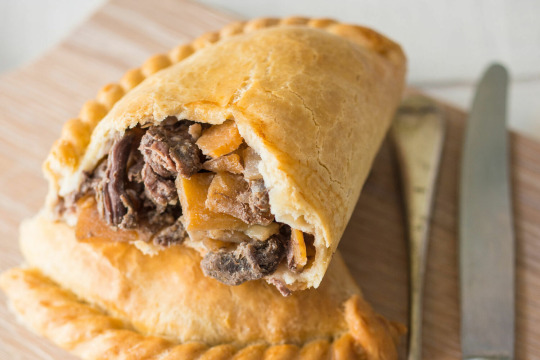
Cornish pasty! this is a little pastry pocket with a meat and veg filling that has PGI status. the traditional and authentic filling is; beef, turnip, potato and onion with salt and pepper, the ingredients make their own gravy inside the pastry case and their original purpose [as with a lot of these pastry held meat and veg dishes; may have been to provide a meal to workers who did manual labour in mines, they could get the pastry dirty and discard it while still enjoying the filling.

the toad in the hole! no toads harmed in the making of this; this is a pancake-esque batter and sausages in a tray that are cut into portions, usually with mash potato or roast potato and gravy! quite often if we made this and had left over batter, we'd make pancakes for dessert, so we liked our batter quite plain; but you can add all sorts of seasonings to it!

proper fish and chips, down south in particular we love it with a curry sauce that's particularly unique to fish and chip shops, it's mild and very thick, similar to a westernized chinese curry sauce [you'll often find mixes for it in stores called 'chip shop curry sauce'] our fish and chips is generally going to be a chunky piece of white fish, cod or haddock but it can be other fish as well, along with chunky hand cut chips that slightly resemble steak fries, but they're much softer. not personally my favorite, but i didn't grow up eating a lot of fish!
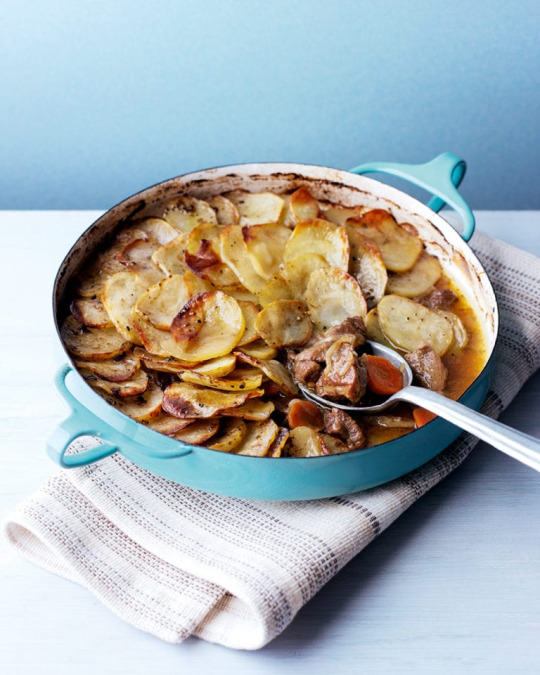
lancashire hotpot, this is a stew of lamb and veggies in a rich gravy topped with very thinly sliced potato that turn into little crisps on top, it's fun to eat around a table with family when it's cold, since it's super rich and fatty

the scotch egg! imagine a jammy boiled egg concealed in a meatloaf-esque meatball that's been coated in breadcrumbs and fried, then you have a scotch egg! personally i love to make these fresh and the store bought cold ones just don't compare, they can be fiddly to make right, but they're just very fun things

probably one of our most loved curries in the UK, theres some controversy over who created it, between a chef from glasgow and our large south asian community, but we all agree that it's wonderful and easy to prepare and a great introduction to get fussy kids to try curry
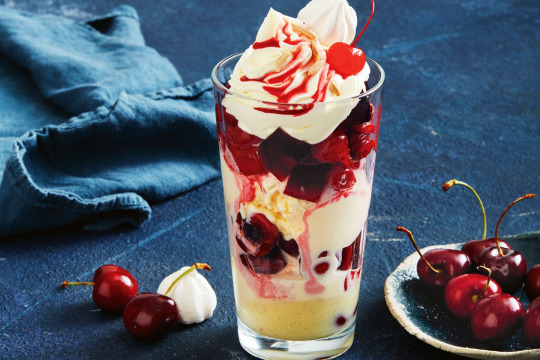
knickerbocker glory is a hilarious name, but really it's just an ice cream sundae rippled with raspberry syrup with fresh fruits, you find them a lot by the seaside! sometimes these sundaes will also have jellies and custards included, but from my experience, vanilla icecream, raspberry syrup, fresh fruit, whipped cream and a cherry on top is the classic

banoffee pie! this is a no bake pie similar to a no bake cheesecake. it's a crumbly biscuit and butter base with layers of toffee sauce, bananas and cream on top, it's very rich and indulgent and always makes a mess

and at request of my US living fiance, his absolute favorite, sticky toffee pudding! this is a hot steamed sponge cake with chopped walnuts and dates with a sticky toffee sauce that's drizzled on top [or sometimes injected into the cake itself] it's incredibly rich and best served with icecream!
#i took so much time writing this out that if anyone decides to be a clown in the notes they're getting blocked#just to get that out of the way#anyway#enjoy foods from the UK that we ACTUALLY eat and not weird stuff that no one really cares about!#also all things i myself have cooked for myself and my family/partner#food images
36 notes
·
View notes
Text
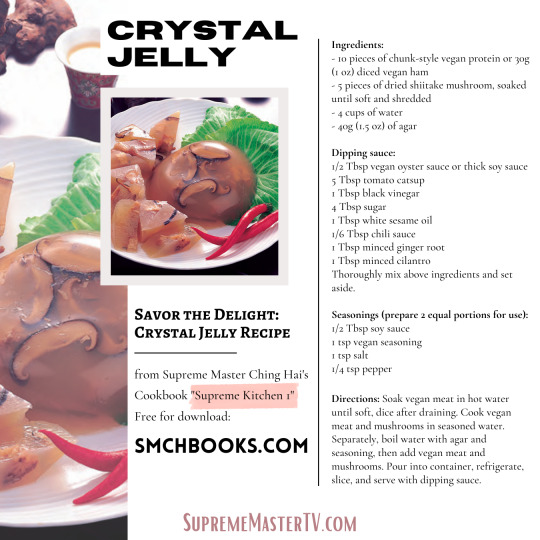
Recipe from Supreme Master Ching Hai's cookbook "Supreme Kitchen 1" - Free for download at SMCHBooks.com
Ingredients:
10 pieces of chunk-style vegan protein or 30g (1 oz) diced vegan ham
5 pieces of dried shiitake mushroom, soaked until soft and shredded
4 cups of water
40g (1.5 oz) of agar
Dipping sauce:
1/2 Tbsp vegan oyster sauce or thick soy sauce
5 Tbsp tomato catsup
1 Tbsp black vinegar
4 Tbsp sugar
1 Tbsp white sesame oil
1/6 Tbsp chili sauce
1 Tbsp minced ginger root
1 Tbsp minced cilantro
Thoroughly mix above ingredients and set aside.
Seasonings (prepare 2 equal portions for use):
1/2 Tbsp soy sauce
1 tsp vegan seasoning
1 tsp salt
1/4 tsp pepper
Directions: Soak vegan meat chunks in hot water until soft. Then squeeze out excess water and dice. Place vegan meat and mushrooms, together with 1 cup water and 1 portion of seasoning mixture, into a small pot and cook over medium low heat for 5-6 minutes. Remove from pot and set aside. Into another pot, add 4 cups of water and the other portion of seasoning mixture and bring to a boil. Add agar and continue boiling until agar melts. Then add meat chunks and mushrooms and again bring to a boil. Pour mixture into a round container, allow to cool, then place in refrigerator for at least 20 minutes. Invert onto a serving platter and cut into slices. Serve with dipping sauce.
*The dipping sauce is also suitable for use with boiled potatoes, Chinese yams, cauliflower, mushrooms, okra, eggplant, etc.
Direct link: https://smchbooks.com/index.php?route=product/product&product_id=953
✨✨✨✨✨✨✨✨✨✨
💗 Please join Supreme Master Ching Hai to sincerely thank God Almighty for World Vegan, World Peace and souls’ Liberation 💗 Every day at 9:00 PM Hong Kong time 🙏
SupremeMasterTV.com
#SupremeMasterTV#SupremeKitchen1#VeganRecipe#SMCHBooks#HealthyCooking#PlantBased#VeganCookbook#Homemade#HealthyEating#CookingTips#MeatlessEveryday#RecipeOfTheDay
2 notes
·
View notes
Text
Qualinesti Vegatable Stew
Serves 4
Ingredients: 1/3 cup extra-virgin olive oil, 5 Garlic cloves, finely chopped, 2 Teaspoons minced fresh thyme, 1 Large yellow onion, finely chopped, Kosher salt, 1 (15-ounce) can tomato puree, 1 Teaspoon sugar, Freshly ground black pepper, 1/4 Cup chopped fresh basil, 1 Zucchini, sliced 1/4 inch thick, 1 Yellow squash, sliced 1/4 inch thick, 1 Japanese or Chinese eggplant, sliced 1/4 inch thick, 4 Plum tomatoes, sliced 1/4 inch thick
Preheat the oven to 375 with a rack in the middle of the oven.
In a 12-inch ovenproof skillet over medium heat, combine 1/4 cup of the olive oil, half the garlic, and the thyme and cook, stirring, until fragrant and the garlic just begins to sizzle, 1 to 2 minutes. Scrape the mixture into a small bowl and set aside.
Add the remaining oil to the skillet over medium heat and allow the oil to warm until shimmering. Add the onion and 1/2 teaspoon salt and cook, stirring, until fragrant, 1 minute. Add the tomato puree, sugar, and pepper to taste. Bring to a simmer and cook, stirring occasionally, until slightly thickened, 7 minutes. Adjust the seasoning with additional salt, if necessary, and set aside off the heat to cool slightly. Add 2 tablespoons of the basil and stir to mix; spread and smooth the mixture into an even layer in the skillet.
Working in concentric circles from the edges of the skillet toward the middle, neatly shingle the sliced zucchini, yellow squash, eggplant, and tomatoes, alternating and overlapping the vegetables and packing them tightly in a single layer. Drizzle the reserved garlic-thyme oil evenly over the vegetables and sprinkle with about 3/4 teaspoon salt and 3/4 teaspoon pepper. Cover the skillet and bake until the vegetables begin to soften, 30 minutes. Remove the cover and continue baking until the vegetables are very tender and bubbling around the edges of the skillet, 20 minutes.
Rest the dish for 10 minutes, sprinkle with the remaining 2 tablespoons basil and serve.
Note: Japanese and Chinese eggplants are long and slender, with a diameter similar to that of zucchini or the fat end of yellow squash. If you use glove eggplant instead, choose the skinniest one you can find and cut the slices to a similar size as the squashes and tomatoes. Make sure the curved side faces out when you arrange them in the skillet.

Source: Heroes Feast
2 notes
·
View notes
Note
I also made some meatloaf recently, using the binging with babish recipe. Also made mashed potatoes and brussel sprouts 💯💯💯
Do you use breadcrumbs? Also, got any good sides?
sorry my ass took a week to respond BUT
Yeah i modified babish's recipe so i do make a base out of the shredded veg and the breadcrumb/egg/milk mixture but i just go fucking insane with my seasonings to really make sure the loaf is flavored thru im adventurous with my seasonings which helps a ton!!
as for sides: Sweet corn (on or off the cob) with lots salt pepper and some chili flakes for some warm heat [Or chili powder], Mac and Cheese is the classique and you cant really go wrong, A nice mixed wild rice or rice pilaf, salad of some sort, lil sauted veggies, Spiced Maple seasoning Squash cooked in butter!!! roasted carrots with chinese five spice, u can also roast some small potatoes with curry seasoning. I think warming herbs n spices go awesome with savory meatloaf dishes so dont be afraid to add curry powder, garam masala or just a combo of nutmeg, cloves, n cinnamon to add depth n warmth to any of the sides u feel comfy with!!!
4 notes
·
View notes
Text

[ID: A spoon full of a dark brown liquid lies on a table in front of a jar of the same liquid. End ID]
Usata sosu / ウスターソース (Japanese Worcestershire-style sauce)
Japanese Worcestershire sauce, like its English counterpart, consists of simmered vegetable or fruit juices, sugars, vinegar, salt, and spices. It was first produced by Japanese manufacturers, who modelled it off of imported sauces, in the Meiji era (late 19th century); however, it did not achieve widespread popularity in Japan until after WWII, with the increasing popularity of Western-style food (洋食 / yoshoku).
Japanese Worcestershire sauce is commonly used to flavor okonomiyaki, yakisoba, and yaki udon; it may also be placed on the table in a sauce dispenser alongside soy sauce in restaurants or in the home. In western Japan, especially the Kansai region, it has become so prevalent within yoshuko that the term ソース (sosu), theoretically used to describe any Western-style sauce, usually means Worcestershire sauce.
Common sauces derives from usata sosu are 中濃ソース (chuno sosu), of a medium-thick consistency, and 濃厚ソース (noko sosu), also known as とんかつソース (tonkatsu sosu), of a thick consistency. Tonkatsu sauce also tends to be sweeter, while Worcestershire-style sauce is more heavily spiced.
This is the from-scratch version of a sauce that home cooks in the West sometimes make by mixing pre-made sauces (such as Worcestershire sauce, soy sauce and ketchup) together. Carrots, onions, tomatoes, fruits, spices, and herbs are simmered together to produce a tangy, fragrant sauce, more complex and punchy than the quick version. See my yakisoba recipe for my quick version—it’s still delicious, though mellower.
Recipe under the cut!
Patreon | Tip jar
To make Japanese Worcestershire sauce, you will first need to make a dashi (stock): this recipe calls for a combination of kombu and shiitake dashi and vegetable stock. You will then need to simmer vegetables, fruits, herbs, and spices in the stock. Finally, the sauce should be blended and strained through a fine cloth to remove plant fibers. The sauce may be thickened at this point, if desired.
This recipe makes about 2 cups of ウスターソース (usata sosu).
Equipment:
A nut milk bag or cheesecloth
A large pot
A blender or immersion blender
Ingredients:
For the dashi:
6g (4” x 4” piece) kombu, dirt wiped off but keep white stuff, slit with scissors
3-5 dried shiitake mushrooms (10g)
2 1/4 cups water (to make 2 cups kombu dashi)
2 cups vegetable stock
Fruits and vegetables:
1 yellow onion
1 medium carrot (125g)
2 medium sweet apples (200g each)
1-inch chunk (10g) ginger
2 cloves garlic
1 rib celery (including end and greens, if available)
3 roma tomatoes
2 plums or prunes (optional)
Spices and herbs:
3 bay laurel leaves
1 tsp coriander seeds
12 whole cloves
2 sprigs fresh oregano, or 1/2 tsp dried
2 sprigs fresh thyme, or 1/2 tsp dried
1 tsp cumin seeds
1 tsp freshly grated nutmeg, or 1/2 tsp ground nutmeg
1 stick cinnamon (Indonesian or Vietnamese cassia)
1/2 tsp black peppercorns
Dried bird's eye chili, crushed (optional)
Bay laurel leaves, or Mediterranean bay leaves, are the type of bay leaf most commonly in use in the U.S.A. and Europe. They will have small lines radiating outward from a central vein.
Cassia is the most common variety of cinnamon in North America; Chinese, Indonesian, and Vietnamese (Saigon) are common sub-types. Chinese and Indonesian cassia are thick strips of bark rolled into quills; Vietnamese cinnamon is too brittle to be rolled and is sold in thick chunks.
Seasonings:
⅓ cup soy sauce
6 Tbsp mild vinegar (balsamic, apple cider, or red wine)
2 Tbsp molasses or brown sugar
2 Tbsp date paste (or substitute more molasses or other sweetener)
Salt and ground black pepper, to taste
Thickener (optional):
3 Tbsp tapioca flour

Instructions:
1. Make the dashi. Make “first” dashi (一番だし / ichiban dashi) by soaking kombu and shiitake mushrooms in 2 1/4 cups cold water overnight. Then heat kombu and its soaking water, uncovered, in a sauce pot on medium-low and slowly (over the course of about 45 minutes) allow it to come to a simmer. Occasionally skim off the bubbles at the top to remove unwanted debris. You can skip the overnight soak to make "quick" dashi.
If you already have reconstituted kombu and shiitake mushrooms from making a past batch of dashi, make “second” dashi (二番だし / niban dashi) by simmering them in water for 1-2 hours. Second dashi is a bit less nuanced than first dashi, and so it tends to be used for sauces, stews, and glazes rather than soups.
2. Strain dashi and add 2 cups vegetable stock.
3. Prepare vegetables. Be sure to wash your fruits and vegetables thoroughly, but there is no need to peel them. Chop or dice the carrot, onion, apples, celery, and tomato (smaller pieces, or diagonal cuts, mean more surface area exposed to the stock and so more flavor extraction). Remove seeds from tomato. Slice the reconstituted shiitake mushrooms from making the stock.
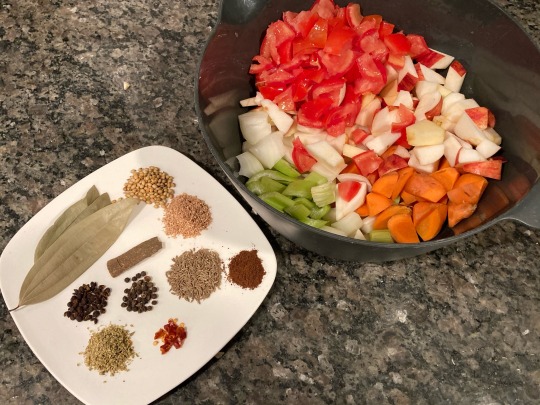
4. Simmer chopped vegetables in the stock, covered, for one hour.

Rather than simmering, it may be possible to use a juicer to extract the flavors from the fruits and vegetables, then simmer the herbs and spices in the resulting juice--but I have not tested the recipe this way.
5. Roughly crush coriander, cloves, cumin, and black peppercorns in a mortar and pestle or spice mill. Add everything in the list of spices and herbs to the stock and simmer for another hour.
6. Remove cinnamon and bay leaves. Use an immersion blender to roughly blend the sauce and then simmer, covered, for another 15 minutes to half an hour (the most surface area is exposed to the stock at this point).
If using a countertop blender to blend the sauce, allow it cool down first.
7. Allow sauce to cool. Strain through a nut milk bag and reserve the pulp for a soup or stew. I had three cups of liquid at this point.
8. Return liquid to the pot and add seasonings. Simmer, uncovered, for about 30 minutes to thicken. Add tapioca starch dissolved in a bit of cool water if extra thick sauce is desired.
9. Taste and adjust sugar, salt. and black pepper (tonkatsu sauce tends to be sweeter than thin Worcestershire sauce, while thin Worcestershire sauce is more spiced). Add a pinch of ground nutmeg and clove, if desired.
Store in a sealed jar in the fridge for several months.
21 notes
·
View notes
Text
thanks for the tag, @liesmyth!
favorite time of the year: autumn for sure; i’m a scorpio, i love the weather and getting to wear sweaters and break out boots and drink cozy spiced things. i also love winter though; big Christmas person, and it’s my favorite time to live in nyc.
comfort food: i like doing long, slow braises in the dutch oven on the weekends, so anything like that. but also Chinese takeout
favorite drinks: i make a different kind of fruit and/or vegetable juice every day, depending on what’s in season, and i’ll try anything tbh. also this time of year i always have cider in my fridge, plus i’ve started mixing chai concentrate and almond creamer and whizzing it up with a frother and it’s. so good.
do you collect anything: not really; pretty books? though a few years ago my aunt thought I’d started collecting salt and pepper shakers and told other people in my family, who all started buying me cute salt and pepper shakers. I have no idea where she got the idea but I have a bunch of very silly ones now that just like take up room in a cabinet do not recommend collecting these btw
current song on repeat: the trapeze swinger by iron and wine, because of the orpheus fic lol
favorite video game: zelda breath of the wild; generally any zelda game. outside of zelda, i put 500 hours into animal crossing nh which seems insane? also just a ton of hours into stardew valley, which I have less shame about; it’s a wonderful game. oh and hades!! I’ve been itching to do another hades run soon.
favorite fic: i’m bad at identifying all-time faves because my brain tends to hyperfixate on things and i can’t even think of other fics i love. so these are drarry fics that are currently living in my head rent-free! ⬇️
yours is the earth (hold on, hold on) by chickenlovespumpkin; i love horror fics, and fucked up relationship dynamics, and alternating timelines (duh). this also has my absolute favorite proposal ever ever. it’s perfect.
I Do Not Love You by @writandromance; i’ve recced this before but it’s genuinely one of my favorite pieces of writing ever. you will never be able to hear the song “piano man” and not want to die. i even made a playlist of all the music the author suggests for each chapter! i’m a pianist, so this fic and the accompanying music just hits me right where i live.
Watch The Castles Burn by @moonflower-rose; this is just a regular rotation reread; i love it so much. so funny, sexy, angsty; the tension is so good and everyone is simply very attractive in this fic.
if you’ve changed your mind by warmfoothills; i love the approach to this fic. it’s so sweet and cozy and has just enough UST and longing for me.
tagging @moony-saraneth, @silverinerivers, @miss-ivyness, and anyone who sees this and wants to do it!
#fic recs#tag memes#if the only thing you take away from this is ''i have to try chai concentrate and make lattes'' then this is a productive post
8 notes
·
View notes
Video
youtube
Stir-fried Sticky Rice Recipe (生炒糯米飯) with Papa Fung, December 23, 2022
An aromatic sticky fried rice loaded with Chinese sausage, dried shrimp, shiitake mushrooms, green onions and some cilantro. The sticky texture is what makes this rice dish stand out. A great crowd pleaser for pot lucks!
Stir-fried Sticky Rice Recipe [生炒糯米飯食譜]
This recipe makes 4 bowls of pan-fried sticky rice [製成四碗]
Ingredients [食材]
500 g glutinous rice [糯米]
2 Chinese sausages [臘腸]
5 shiitake mushrooms [冬菰]
30 g dried shrimp [蝦米]
60 g peanuts [花生]
1 tsp lard [豬油]
A few stalks of green onion [青蔥]
1 stalk cilantro [芫茜]
2 tbsp oyster sauce [蠔油]
8 g sugar [糖]
5 g salt [鹽]
Some white pepper [胡椒粉]
Some sesame oil [麻油]
(250 ml mushroom/shrimp water) [浸冬菰和蝦米水]
Directions [製作]
Soak glutinous rice for 4 hours. Strain and set aside. [糯米浸四小時,瀝乾備用。]
Wash shiitake mushrooms and dried shrimp. Soak until softened. Keep the mushroom and shrimp water for frying the rice later. [冬菰和蝦米先洗乾淨,再軟取出備用,留起水用作炒飯。]
Dice all the ingredients, set aside. [將所有材料切碎備用。]
Melt salt and sugar with hot water, mix until combined. Add in sesame oil, white pepper and oyster sauce, mix and set aside. [鹽和糖先用熱水攪溶,再混合蠔油,胡椒粉和麻油置一旁。]
Roast some peanuts until fragrant, set aside to cool. [白鑊炒熟花生備用。]
Heat up wok, melt lard, stir fry Chinese sausage until cooked, add in shrimp and cook, add in mushrooms, cook until fragrant. [熱鑊放豬油加入臘腸炒熟,再加蝦米炒香,再加冬菰炒至有香味。]
Add in rice, continuously stir and add shrimp/mushroom water a little bit at a time and cook with the lid on to speed up the process. Once the shrimp/mushroom water has evaporated, repeat until the rice is fully cooked. [加入米要不停翻炒,同時加些少蝦米水及加蓋焗至水份收乾,重覆以上步驟至飯熟。]
Once rice is cooked it’ll become sticky, now, mix in sauce that was prepared earlier. [當飯有黏性加入調味料炒勻。]
Lastly, add in some dark soy sauce for some colour, and cilantro and green onions, and mix until combined. [最後加些少老抽調色和加芫茜和青蔥炒勻即可。]
Place some cilantro and peanuts into the bowl, followed by the rice, flip bowl to reveal the dish and serve. [放芫茜和花生入碗內,加上糯米飯,倒扣在碟上即食。]
***
The twelfth lunar month is called laap yut (臘月), the cold and dry weather being appropriate for drying and curing. Some recipes call for cured pork belly (laap yuk, 臘肉), cured belly to go with the (Southern) Chinese sausage (laap cheung, 臘腸) which are traditional season staples. Lard and sources of it were a year-round necessity for oil, fuel, flavouring, and caloric density but particularly important during lean months like the height of winter. Most of the ingredients for stir-fried sticky rice are dry or stable preserved goods that balance out the strong and rich pork and lard.
I made a batch Thursday for the winter solstice (Dongzhi, 冬至) using a different recipe. Like a lot of seasonal and festive foods the idea remains the same while the specifics change, and there may be something new for me to adopt from this version.
My mom used to use a rice cooker to steam the glutinous rice keeping it on the firm side, combining everything in the wok at the end. While soaking then stir-frying the rice from raw to cooked (as the name of the dish states) isn’t actually too bad adjusting for the size of wok or pan but it does take time and practice. I’ve taken to seasoning the soaked and drained rice by mixing it with a bit of oil and salt in a bowl while preparing everything else. The added oil from stir-frying seems to need a heavier hand with seasoning (like oyster sauce, added salt, or soy sauce) than with steaming the rice.
After soaking, squeezing out most of the excess water, and dicing the mushrooms, she always marinated them with some oil, light soy sauce, and sugar. There was also soaked and shredded dried scallop (conpoy or gong yiu chyu, 乾貝 / 江瑤柱) in addition to the small, dried shrimp when we had some.
One thing glossed over in the video is that the water can have sediment at the bottom; the initial washing leaves sand and grit that is released after rehydrating and should be discarded. This cold broth from soaking the dried ingredients adds to the savouriness of the rice along with the sausage and lard. The added oyster sauce in this and other recipes boosts the concentrated seafood accent. In the rice cooker/steamed rice version, the broth can be used to cook and soften the stir-fried sausage, mushrooms, and dried seafood, covering and reducing it fully before adding the rice.
A quality dark soy sauce is often enough to colour and flavour the fried rice. The addition of white pepper and sesame oil to the sauce for the rice is new to me, though I imagine it cuts through the pungency of fat and the concentrated seafood and reducing the additional lard needed.
Peanuts, cilantro, and green onion are not essential, though they do add to the texture and freshness when the overall dish can be heavy. These are often garnishes added last as it is often reheated, softening the peanuts and the greens darken while losing flavour and crispness. Less and less restaurants bother with the peanuts at all: they become hard especially if fried or roasted and stale while others overcook the peanuts by boiling or with steam becoming bulk rather than texture. It’s easy to see why peanuts could be cut from an already long list of ingredients. One local dim sum has replaced them with what I’m certain is rendered pork rinds for a sturdier crunch. There’s probably an element of adapting it with more sensitivity towards peanut allergies, while at home we never had them as a staple.
Another common addition to improve the overall dark colour is thinly-chopped omelette or a fine scramble. It was fashionable for a time at some restaurants to wrap it omurice-style or reheat portions with rehydrated lotus leaves to impart a different scent. Some recipes use a long grained glutinous rice or cut it with white rice to soften the chew but in the wrong proportion it compromises the structure and ability to keep or reheat. There was a decade where places would just steam portions in the bowl upright and uncovered resulting in a soggy fried rice.
Turning the rice out moulded with a bowl is solid, old-school presentation, it demonstrates how well the rice is made: sticky enough to hold a shape even when portioned; the thorough and even mix of ingredients, colour, and flavouring without overworking; and a careful stir-fry that is oiled enough to release. A good fried rice, sticky or otherwise, needs a shine without being greasy.
#food#Chinese#冬至#seasons#time#winter#cooking#生炒糯米飯#臘月#Papa Fung's Kitchen#Dongzhi Festival#real life#notes
5 notes
·
View notes